Related Tags
How to buy a vintage Fender Telecaster
Looking to add a vintage Telecaster, Nocaster, Esquire, Broadcaster, Thinline, Deluxe or Custom to your collection but don’t know where to start? Let us be your guide.
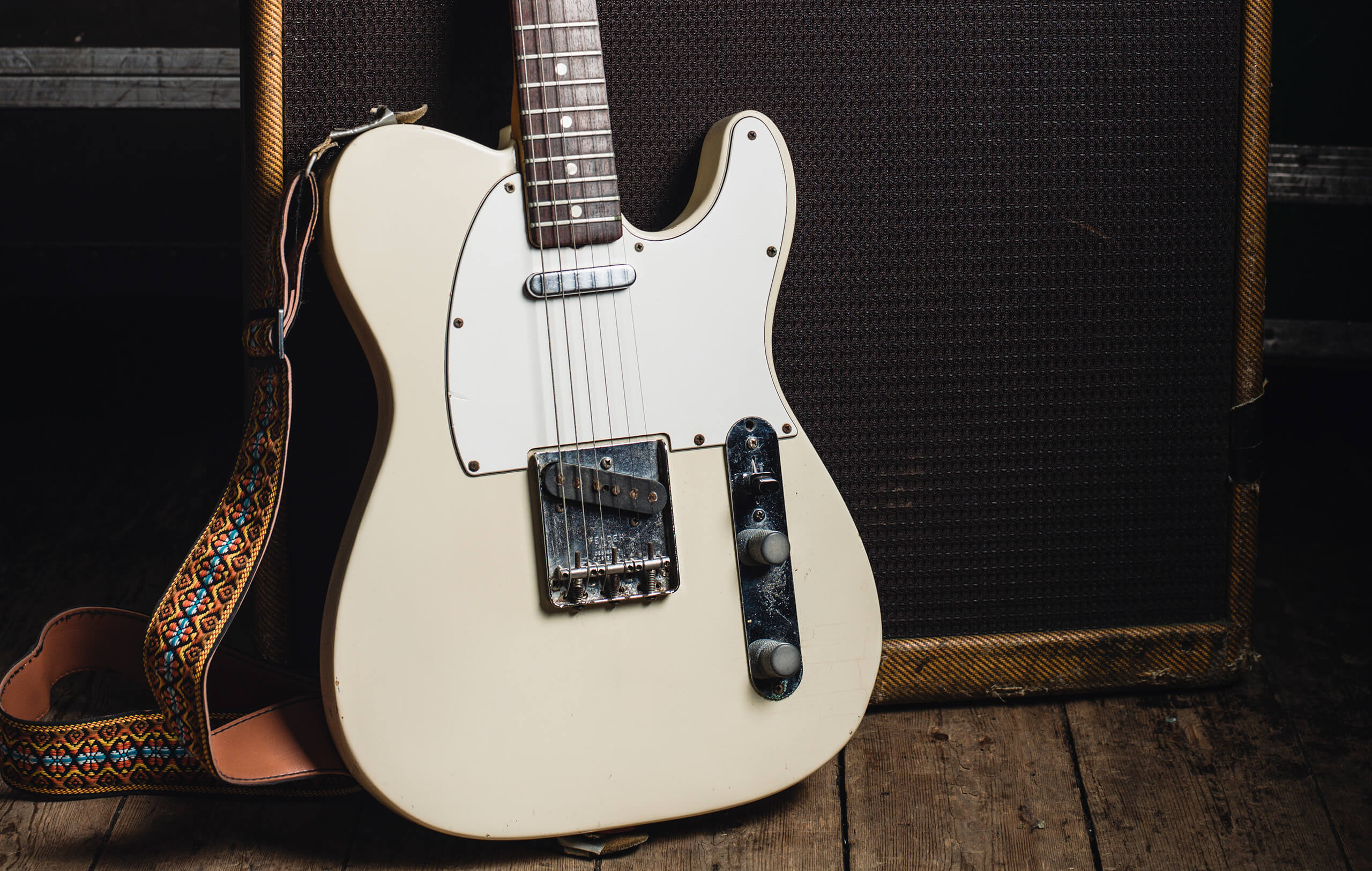
All images: Eleanor Jane
Leo Fender and his then business partner Doc Kauffman began discussing the idea of a solidbody Spanish guitar as early as 1943 but Leo only began working on the project at the start of 1949. The first prototype was a single-pickup model with a pair of knobs mounted on a rectangular metal plate and a two-piece laminated pine body. A curved metal plate covered the bridge while, decades later, the black pickguard would influence the design of other models in the Telecaster family such as the Cabronita.
- READ MORE: How to buy a vintage Fender Stratocaster
The most distinctive feature of Leo’s early prototype design was the ‘snakehead’ headstock with three-per-side tuners. It’s thought this guitar was made during the summer of 1949 but many of the iconic Telecaster features were already present.
After sending prototype number one out for field testing, Fender developed a second prototype. It was made during the autumn of 1949 and the three-saddle bridge, pickup mounting arrangement and through-body stringing would make it to the production version. At this stage, the design still featured a single pickup, but the headstock and tuner placement looked like the finished article.
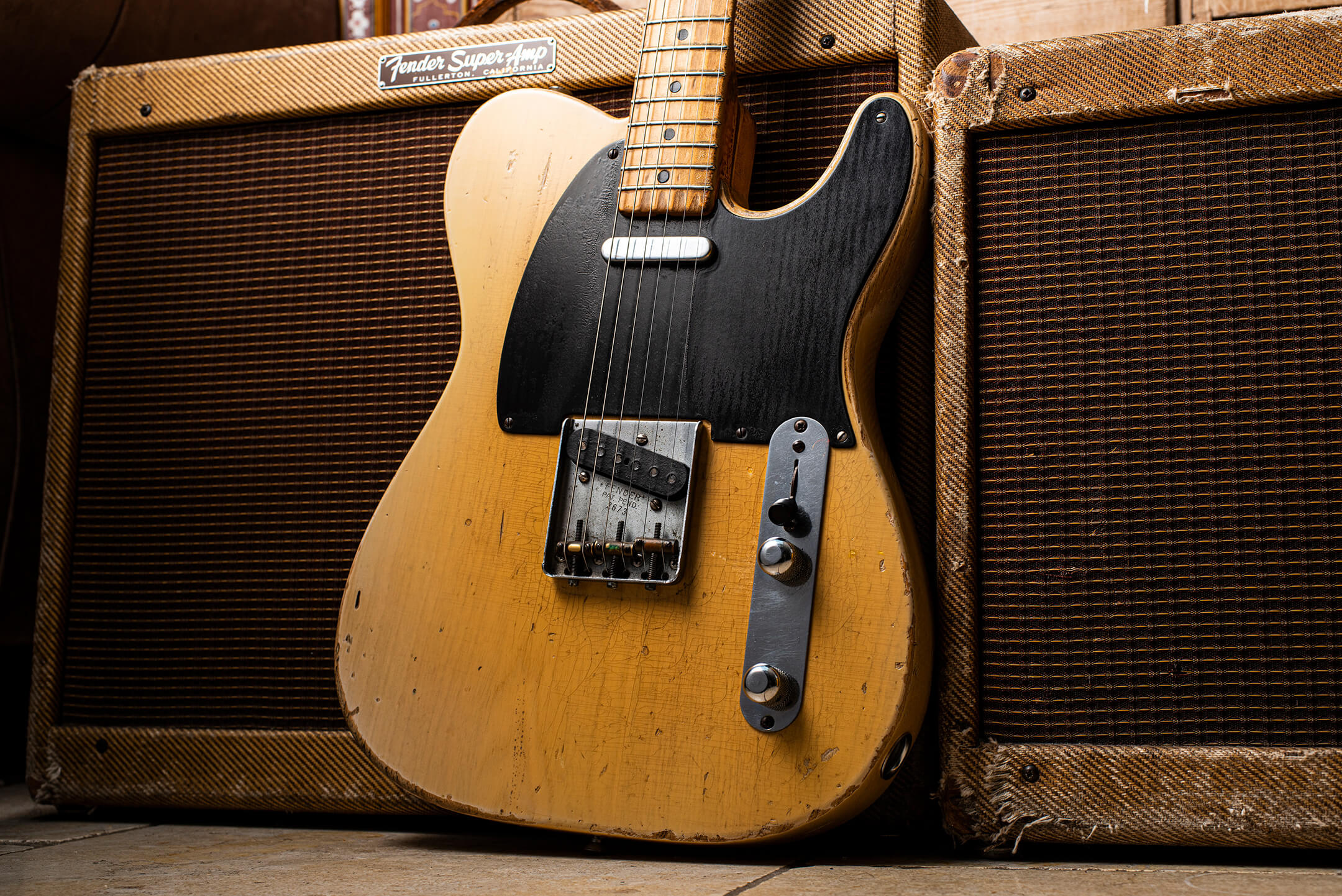
First production models
Fender’s first production guitars were made during the spring of 1950. Named Esquires, they had no truss rod or string retainer on the headstock. The 1.5-inch thick bodies were made from sandwiched pine and there was no router hump in the cutaway. Some were finished in black and had white fibreboard pickguards.
Another prototype is regarded as Fender’s first two-pickup guitar. Leo hadn’t designed a neck pickup, so he used a Champion lap steel pickup instead. Most first-batch Esquires had a single pickup, but some had two.
The purchase of special tooling in October 1950 indicates that Leo was persuaded of the need for truss rods and early truss-rod-equipped necks had walnut or maple headstock plugs. By then, Fender had started using ash for the bodies and Don Randall had devised a new name to differentiate the single and double pickup models. The Blackguard era had begun.
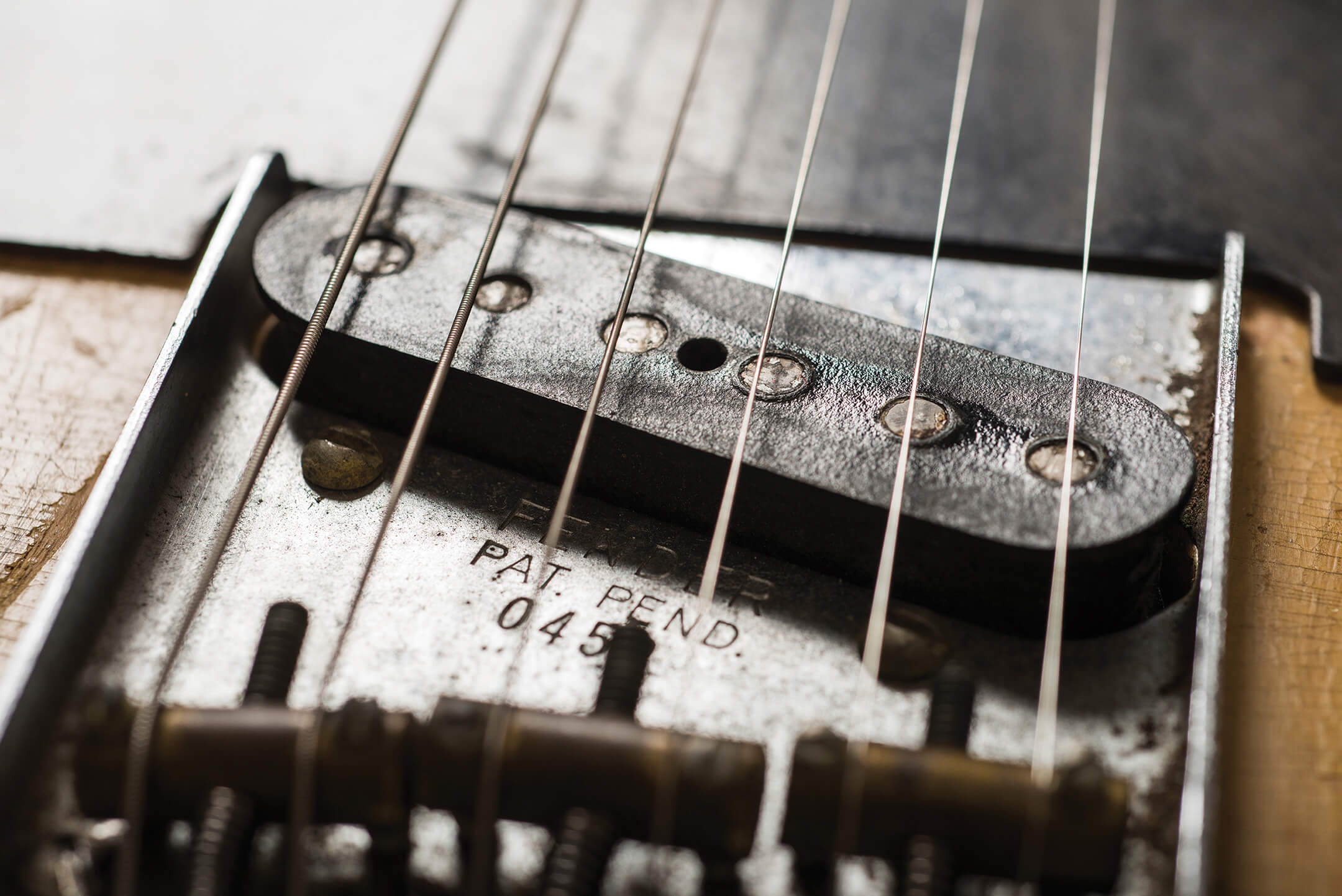
Blackguards
Blackguard is an umbrella term that covers early Esquires, Broadcasters, Nocasters and Telecasters. Why the name change? Gretsch had already used the name Broadkaster for a drum kit so Fender complied with Gretsch’s request to desist. Rather than waste decals, Fender simply snipped off the ‘Broadcaster’ section, leaving just the Fender logo – hence the nickname ‘Nocaster’. Blackguard aficionado Nacho Baños estimates that only about 250 Broadcasters were produced, and Nocasters lasted from February until around September 1951, when Telecaster decals first appeared.
The instruments’ black pickguards were made from vulcanised fibreboard, oversprayed with lacquer. The ’guards were placed on a tin for spraying, which left a circular mark on the rear. Other 1950 specs include closed-shell Kluson tuners with ‘Pat. Applied’ stamps on the side and rear, and flat-bottom 5/16” diameter saddles – mostly brass but sometimes steel. Also look for milled jack cups and a ‘Pat. Pend’ stamp on the bridge plate, along with a serial number.
Baños highlights the distinctive shape on the neck’s side edges that is only seen on Broadcasters and early Nocasters, and it’s something we noted during our own Broadcaster encounter, with the instrument having the most sculpted and refined maple neck we had ever encountered on a 1950s Fender. In contrast, Fender struggled to drill the ferrule holes in a straight line.
Early pickups had flat alnico III polepieces, zinc-plated induction plates and were wound with 43 gauge plain enamel wire. The bridge pickup wire changed to 42 gauge around the time of the Telecaster rebrand. The controls were volume and blend, with the muffled faux-bass tone in the front position, then neck and bridge.
You will see router template holes on the heel and under the D tuner on the neck, and there should also be two dowel holes on the back of the body, along with nail holes near the upper side of the neck pickup cavity, under the bridge and on the cutaway horn.
All bodies are ash and there should be no diagonal route between the neck pickup and control cavities on Broadcasters and early Nocasters. Instead, a hole was drilled from the truss rod notch in the neck pocket to the bridge pickup cavity. Although lightweight swamp ash is closely associated with 1950s Fenders, some early Blackguards can be quite heavy.
All the screws should be flatheads – including the truss rod screw – up to late 1951 when Fender began using crossheads. The company didn’t complete the transition until 1953. In 1951 Fender used ‘transition’ tuners with a closed casing and no Kluson Deluxe stamp or ‘Pat. Applied’ stamp on the side. These lasted until early 1952, when Fender changed to open-case, no-line Klusons with the rear ‘Pat Applied’ stamp, and they stuck around until early 1957.
In late 1952, Fender changed from the blend circuit to an arrangement with a preset treble roll-off in the front position, the neck with a tone control connected in the middle and the bridge with no control in the back position. The one-inch dot spacing at the 12th fret was increased by 1/8” in 1953 and the Blackguard era was almost over.
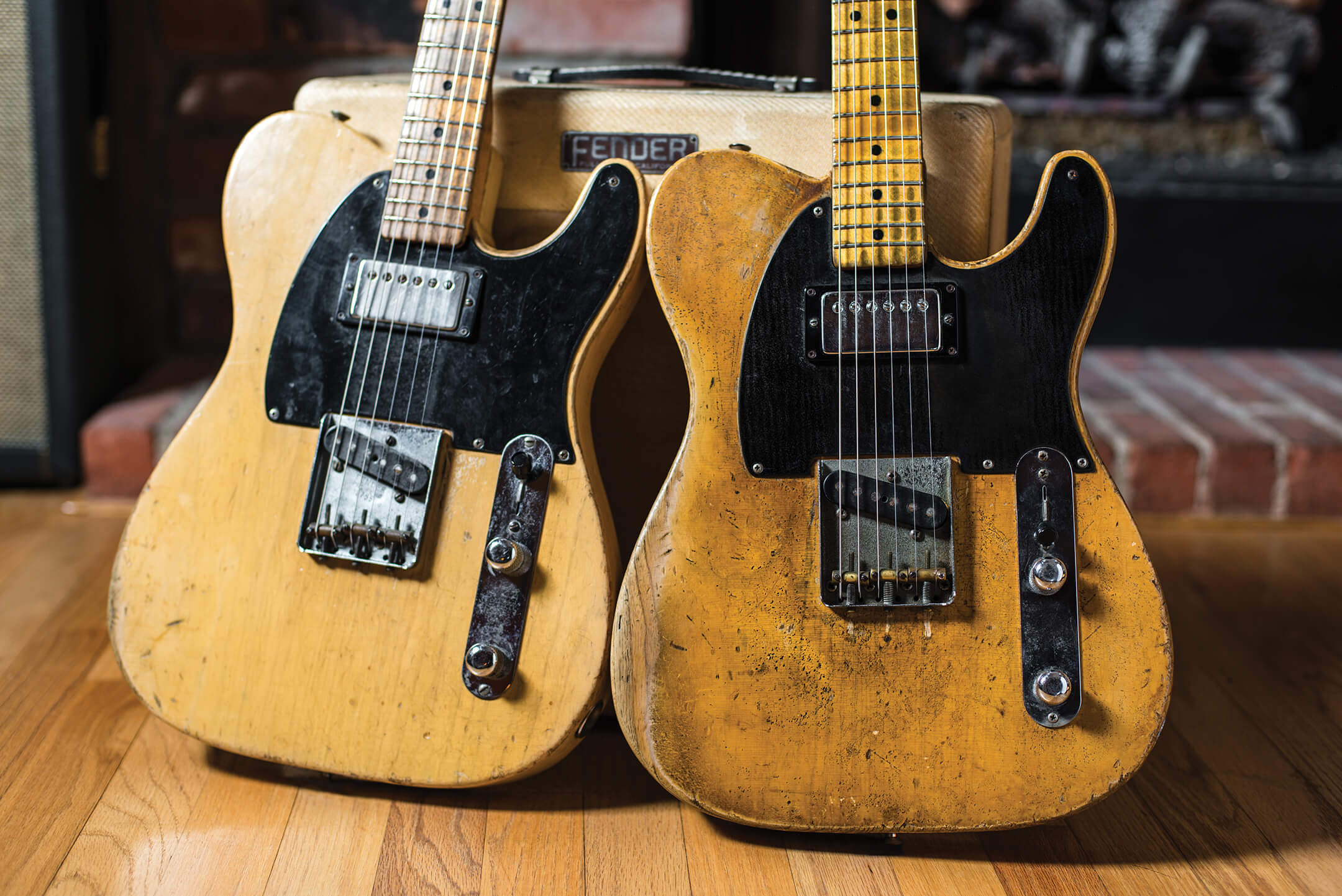
Whiteguards
During the summer of 1954, Fender freshened up the Telecaster with a white ABS plastic pickguard and a lighter shade of finish that allowed more of the ash grain to show through than the Blackguard’s butterscotch had. Serial numbers began appearing on the neck plates rather than the bridge, and saddles were reduced in diameter by 1/16” to 1/4”. The round switch tip was also phased out in favour of a ‘top hat’ design.
The Stratocaster was introduced in 1954 with heavy formvar pickups. Telecaster pickup magnets changed to alnico V around this time, and there are reports of very rare formvar-wound Tele pickups from around this time. Changes continued in 1955, with the introduction of staggered magnets in the bridge pickup. Fender also produced a limited run of Sunburst Teles, and the body pencil dates moved from the neck pocket to the neck pickup cavity.
In 1956, the ‘butterfly’ string retainer replaced the earlier round type and the location shifted towards the nut. The headstock decal was relocated to the other side of the retainer and set at an upwards angle. Flat-top knobs with a soft knurl were another new feature.
A few more sunbursts were made in 1957, and the neck profile tended towards a pronounced ‘V’. We’ve steered away from generalising about neck profiles because they varied so much depending on who carved them, but Fender necks became more standardised as the 1950s progressed.
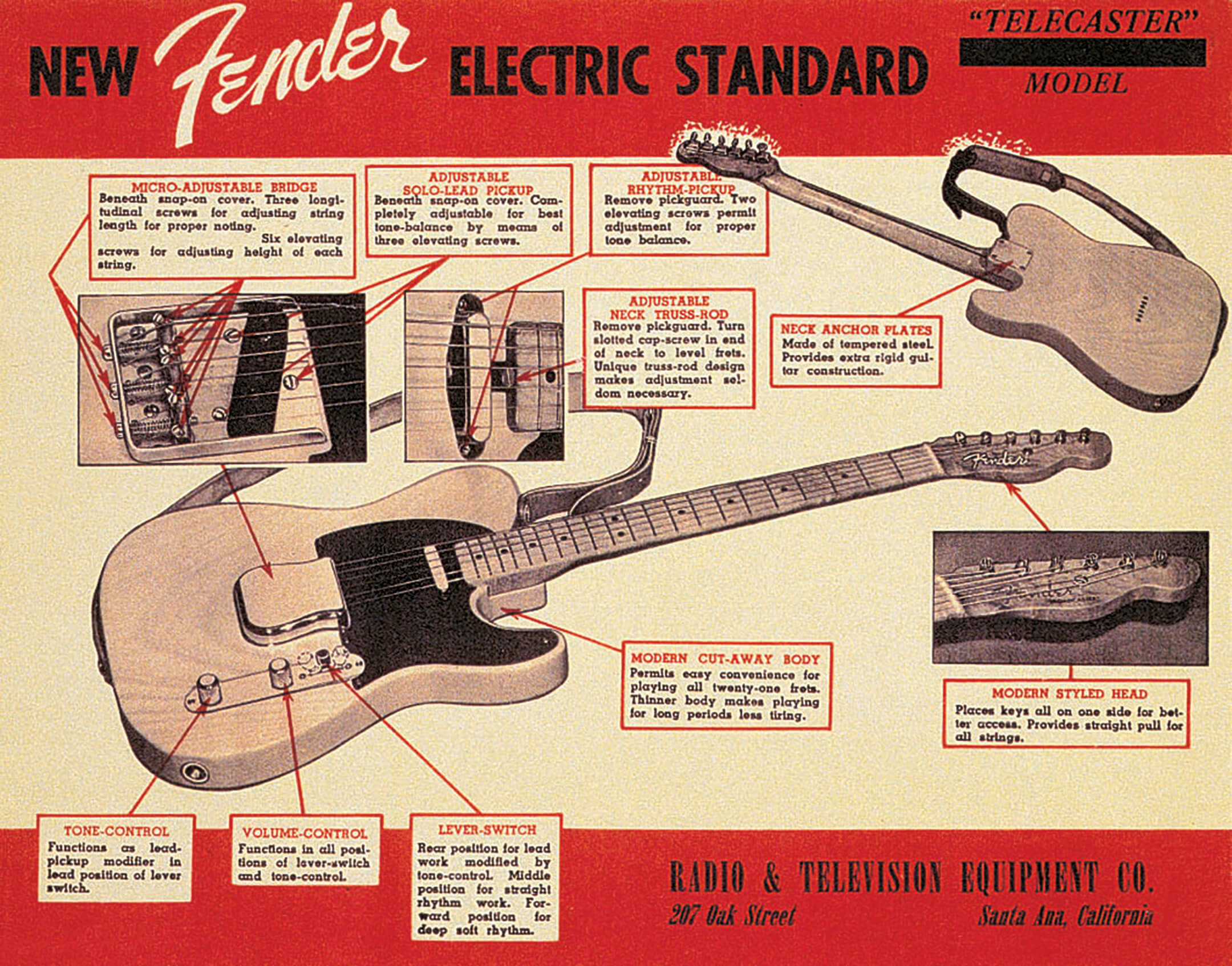
Top-loaders
In 1958, threaded steel saddles replaced the smooth ones and a slimmer ‘D’ neck profile was introduced. More significantly, and controversially, Fender changed to a top-loader bridge design. With string holes drilled at the rear fold of the bridge, Fender didn’t have to drill holes through the body or install ferrules.
This has historically been viewed as a downgrade – but don’t knock it if you haven’t tried it. Top-loading Telecasters have their fans and we haven’t noticed any negative impact on tone or sustain. Indeed, the playing feel gets a little slinkier. If you’re not convinced that top-loader Teles are cool, try listening to Jim Campilongo and some early Jimmy Page. Nevertheless, Fender abandoned top-loading in 1959 and reverted to through-body stringing.
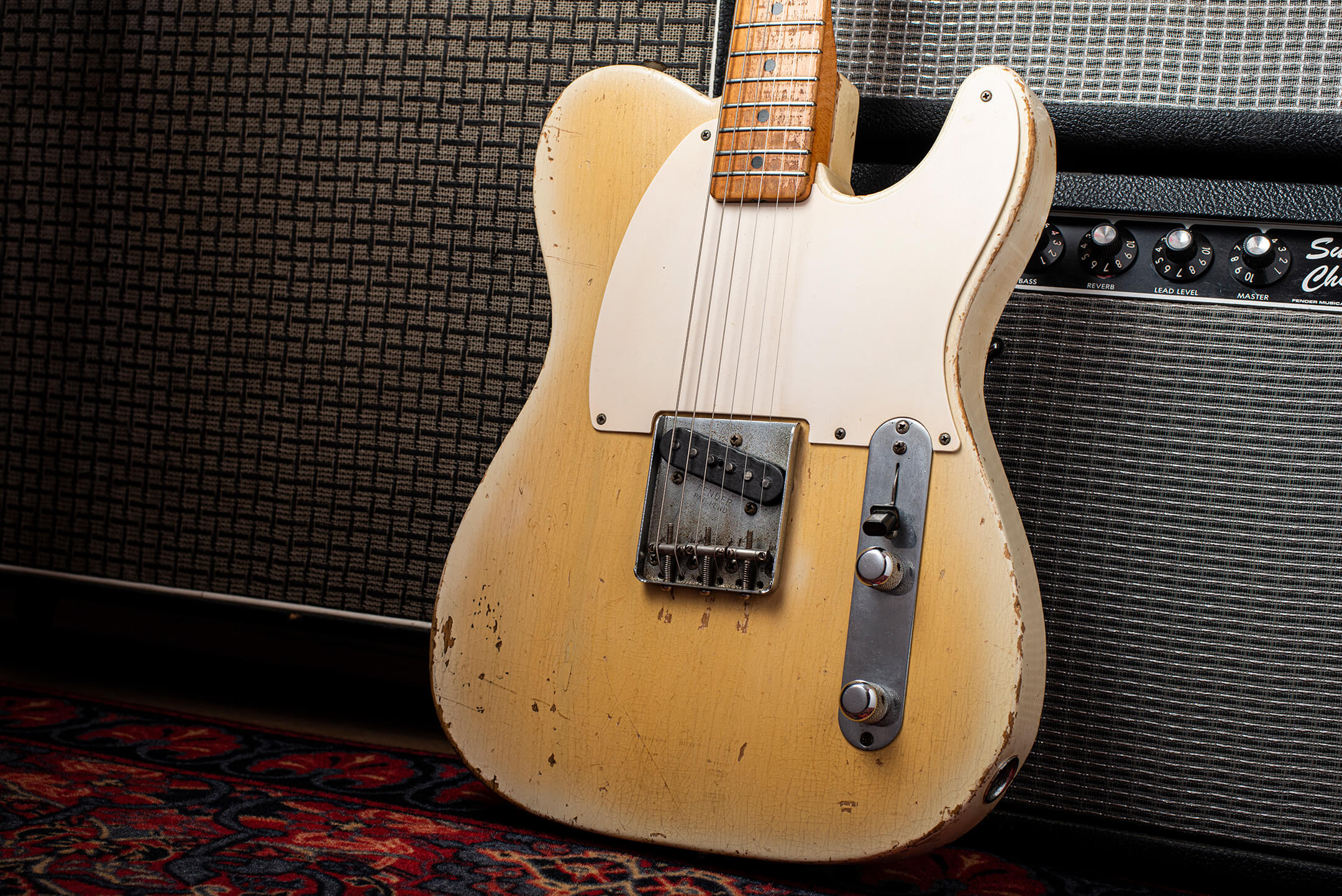
Rosewood & alder
Top-loaders spanned the period in which Fender made other significant changes. In mid 1959, Fender reconfigured its necks for rosewood fretboards. One-piece maple necks were a thing of the past, and while maple fretboards were still available to order, they were glued on in the same way as the slab rosewood boards.
It’s difficult to pinpoint when Fender began using alder for Tele bodies, but it probably coincided with the introduction of custom-colour options. Ash remained the wood of choice for blonde finishes. The overwhelming majority of mid-late 1950s Teles were blonde and ash would continue to be used throughout the 1960s and beyond.
Custom Telecaster & Esquire
Fender used alder for sunburst Custom Telecaster and Esquire bodies on their introduction in June 1959. Maybe Fender was trying to achieve a more upmarket look with the Custom models, because the distinguishing feature is single layer of white binding on the front and back of the body.
The decal was subtly altered, with ‘Custom Telecaster’ in a pseudo gothic font under the spaghetti logo, and they were also fitted with green nitrate pickguards. Regular Teles retained single-ply white ’guards.
In the mid-1960s Fender developed ‘tuxedo’ Custom Teles and there were two versions – a black body with white binding and the reverse tuxedo with a white body and black binding. Fender continued making these into the early 1970s but they are extremely rare.
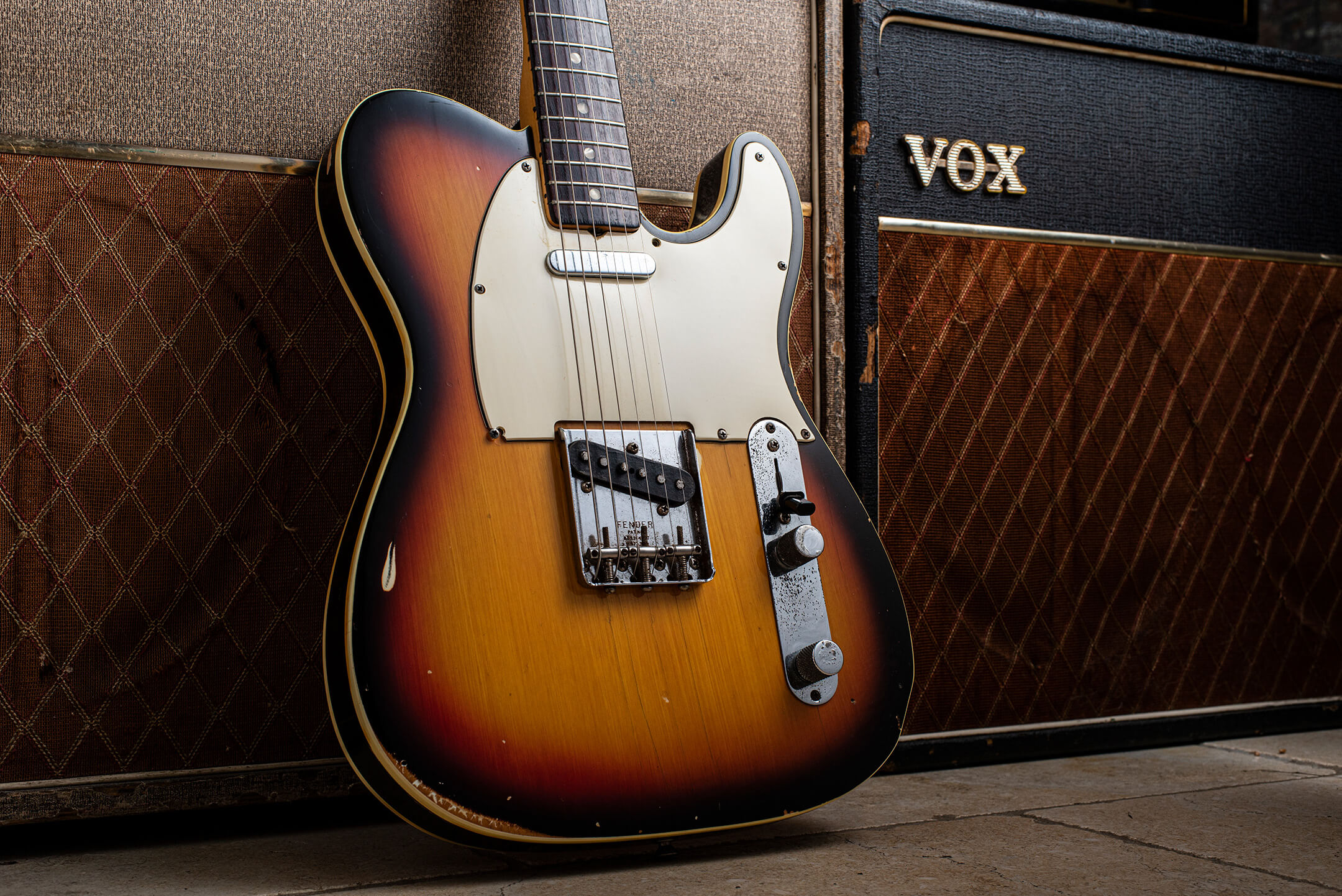
Sixties style
Custom features kept pace with the changes to regular Teles, acquiring white three-ply pickguards in the mid 1960s and moving from the spaghetti logo to the transitional logo in 1964 and then the black block logo by 1968.
Other changes that occurred throughout the Telecaster line included a new white Chiclet tone capacitor in 1959, and the introduction of ceramic caps in 1961. Patent numbers and a DES number were also added to the decal that year.
Veneer rosewood boards replaced slabs in 1962 and pearloid dots replaced the ‘clay’ type in 1964. In 1967, ‘F’ stamped tuners replaced the double-line Klusons that Fender had begun fitting around the time of the CBS takeover.
Fender introduced grey fibre pickup bases in 1964 but persisted with 1950s wiring scheme until late 1967 – finally adopting the neck/both/bridge with shared volume and tone controls that most Tele players had preferred all along. They also added a 0.001uF treble bleed capacitor to the volume control.
In 1969, Fender replaced the 250k potentiometers with 1M and some pickups were potted in lacquer rather than wax. These factors can combine to make Teles of that era shriller and prone to squealing.
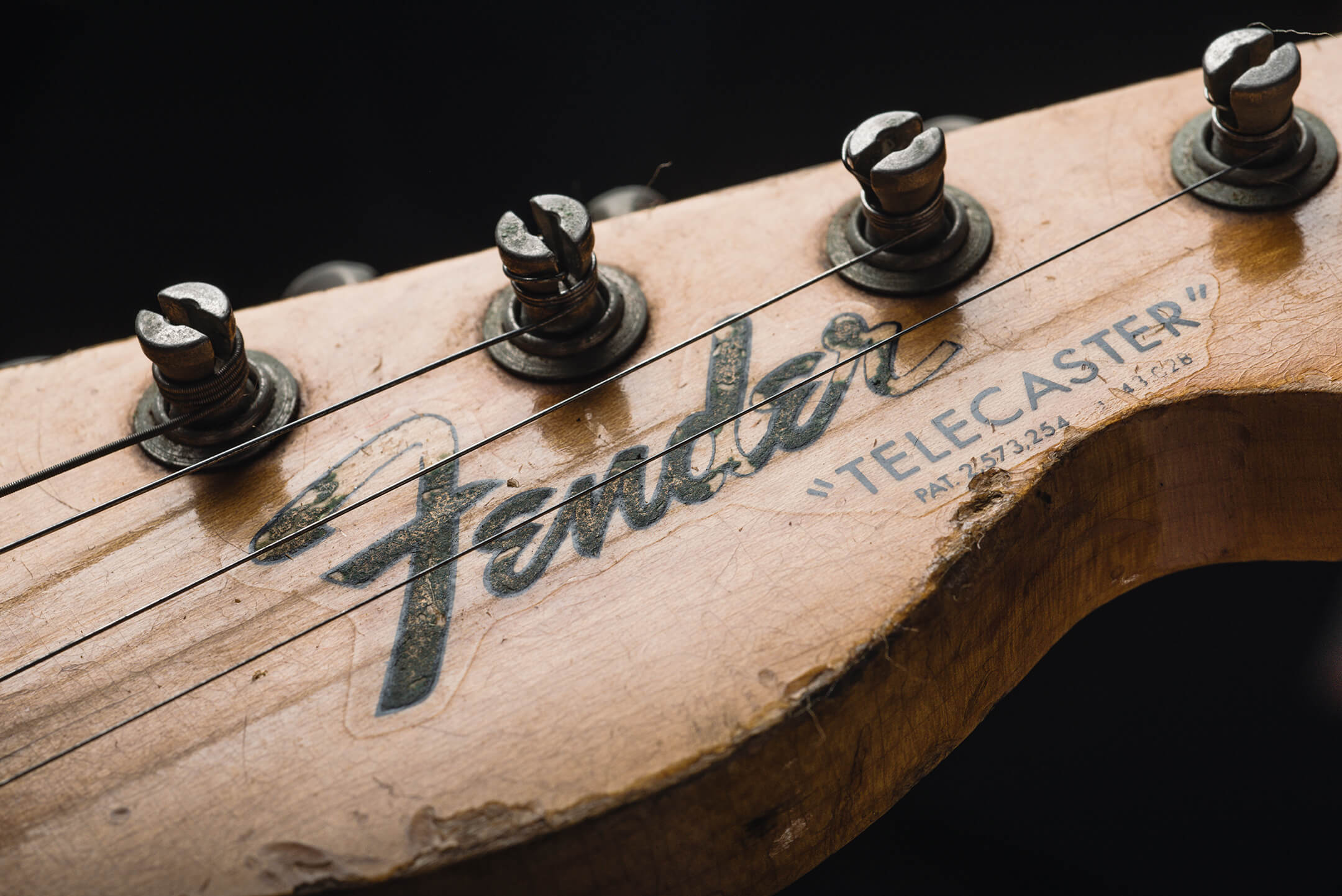
Weight relief
With the exception of some early Blackguards, Telecasters of the vintage era usually had fairly light bodies. Maybe lightweight ash was becoming harder to source in sufficient quantities, because around 1967 Fender briefly experimented with weight-reducing routs under the pickguard. These guitars are known as Smuggler’s Teles because the routs provided the potential for concealment. It was the 1960s, after all…
Fender’s design guru, Roger Rossmeisl, came up with a more effective way of using heavy wood. By routing mahogany bodies from the back to remove most of the wood, and glueing a cap over the chambers, Rossmeisl effectively created a semi-solid Telecaster.
The Telecaster Thinline debuted in late 1968 and also featured a redesigned pickguard, slanted controls and an f-hole on the bass side. Regular Tele pickups were installed until late 1971, when Thinlines acquired the Seth Lover-designed Wide Range humbuckers.
Although not officially designated a ‘Thinline’, the Rossmeisl designed rosewood-bodied Telecasters were constructed in much the same way. The differences are that they have no f-hole and rosewood sandwich bodies with a thin maple filling. Fender only made these for a couple of years from 1969 and it should be noted that the rosewood Telecaster prototype George Harrison played with The Beatles was completely solid.

Flower power
Two of the most unusual looking Telecasters of the vintage era were the Paisley and Blue Flower models. Despite their wild appearance, they were stock Teles with striking finishes that were created by covering alder bodies – front and back – with patterned wallpaper.
Fender then sprayed metallic pink or blue around the edges to create a sunburst effect before sealing everything in with clear gloss lacquer. Clear pickguards were used allow the wallpaper to show through and some more metallic lacquer was sprayed on the underside, around the neck pickup cutout, to conceal the cavity.
Few were made between 1968 and 1969 and since this method of finishing was not particularly robust, vintage examples in good condition are hard to find. The Blue Flower version is the rarest, and the most famous Paisley player is James Burton, who used his with Elvis. Over the years, Fender has offered various reissues of both iterations.

Humbucker models
Tele neck pickups don’t suit everybody, and replacing them with a humbucker was one of the earliest and most popular Telecaster modifications. Fender eventually cottoned on but, since Gibson wasn’t about to start selling humbuckers to their main rival, the Californian company had to develop its own.
CBS made countless mistakes, but asking PAF inventor Seth Lover to create a Fender humbucker was a shrewd move. His powerful Wide Range humbucker retained much of Fender’s brighter tonal signature and featured offset magnetic pole screws made from CuNiFe alloy.
The pickup first featured in the double-humbucker Telecaster Thinline in 1971, followed by the Custom of 1972, in combination with a regular Tele bridge pickup. The Telecaster Custom is most closely associated with Keith Richards and in black, it’s a bona fide icon.
Various other colours were available and, as vintage Telecasters go, they’re still relatively affordable. If you can find a lightweight example – and they do exist – they’re also versatile and superb-sounding guitars.
Fender’s attempt to take on Gibson at its own game was the Telecaster Deluxe of 1972. It featured two Wide Range humbuckers, a solid body, fatter frets and a Les Paul-style control layout. A hardtail Strat bridge was used along with a Strat-style neck. Initial sales were disappointing, but they’ve enjoyed a resurgence in recent years and are particularly popular in indie circles. However, with micro-tilt necks and bullet truss rods firmly established, the first golden era of Telecasters had drawn to a close.
For more guides, click here.
